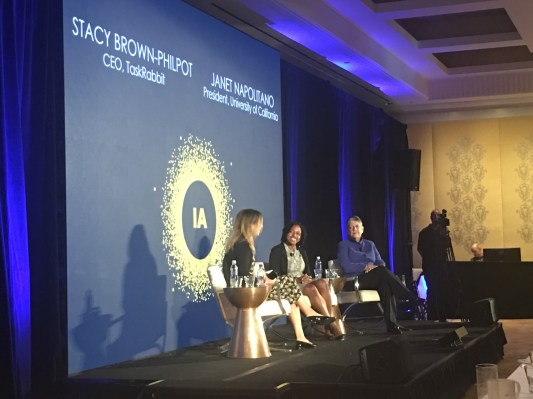Aiming to increase diversity and foster inclusion in the tech industry is not the same as affirmative action, TaskRabbit CEO Stacy Brown-Philpot said on stage today at the Internet Association’s Virtuous Circle conference.
“I wouldn’t say it’s affirmative action but it’s a recognition,” Brown-Philpot said. “Our company should represent the population and we know we have to over-index in certain ways to get there. It’s a belief around being intentional, measuring and holding yourself accountable to real and specific results, and holding yourself accountable in a relatively short timeframe.”
But what Brown-Philpot described fits the definition of affirmative action. TaskRabbit and other tech companies incorporate recruiting strategies like partnering with diversity organizations like CODE2040, devoting 20% of the company’s external recruiting budget to attend at least one career fair a year focused on recruiting black people and posting job descriptions on job boards that target African-Americans — and that’s a good thing. There’s no need to shy away from the “affirmative action” label.
The term “affirmative action” is a loaded one, even though all it really means is that you ensure the employment or admission of people regardless of race and/or gender:
“Affirmative action policies are those in which an institution or organization actively engages in efforts to improve opportunities for historically excluded groups in American society,” according to the National Conference of State Legislatures. “Affirmative action policies often focus on employment and education. In institutions of higher education, affirmative action refers to admission policies that provide equal access to education for those groups that have been historically excluded or underrepresented, such as women and minorities.”
What tech companies say they’re trying to do around diversity and inclusion is affirmative action. Unfortunately, some people associate affirmative action with discriminatory ideas like “lowering the bar” and “reverse racism,” the latter of which is not a thing. Affirmative action can also feel condescending for black people, including myself, when others suggest that our accomplishments are due to affirmative action, instead of as a result of intelligence and hard work.
Although I disagree with what Brown-Philpot said — I think TaskRabbit and others are engaged in affirmative action, and that’s fine — the moderator, Christina Passariello of the Wall Street Journal, set her up with a loaded question. She asked if efforts to include diversity and inclusion were the same as affirmative action, with the implication being that affirmative action is a bad thing. Spoiler alert: it’s not. Ensuring equal access and opportunities for people, no matter what their race, gender, sexuality, physical ability, etc. is how our society should function. But given that our society is not set up that way, thanks to things like years of systemic racism and discrimination, affirmative action is still necessary.
Even after the Supreme Court’s landmark affirmative action decision this summer in Fisher v. University of Texas, it seems that the phrase “affirmative action” is still a sensitive one. Maybe it’s easier for executives like Brown-Philpot to distance their diversity and inclusion efforts from the label. But, with the Supreme Court asserting the legality of affirmative action, what is there to fear from using the phrase?
Brown-Philpot also discussed the importance of companies starting these diversity and inclusion efforts early on, when the company isn’t massive in size.
“When I joined Google it was 1,000 people,” Brown-Philpot said. “It took me two and a half years to look around and realize there weren’t a lot of people like me. So David Drummond and I got together and put together a group.” She later said, “It was really late. I think that’s part of the challenge [Google has] in fixing [diversity].”
During the question and answer portion of the panel, I asked Brown-Philpot about the pressure she feels as one of the few black female CEOs in the tech industry.
“There is pressure,” Brown-Philpot said. “I don’t pretend there’s not.”
She went on to talk about what it was like when she transitioned from a high school that was 98% black to a college, University of Pennsylvania, that was just 6% black.
“There’s an expectation of performance because I made it in some way when other people didn’t,” Brown-Philpot said. “I had no option. Failure was not an option for me. I could not fail.”
